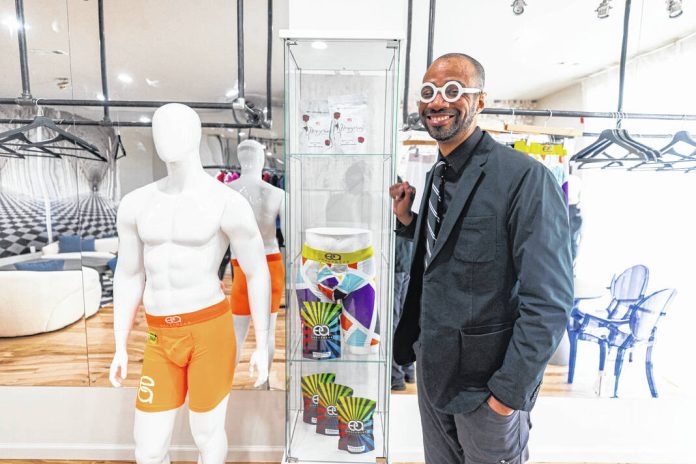PHILADELPHIA — Curiosity may kill the cat but for Nancy Connor and Johnny Goodwin Jr., Philadelphia-based self taught designers, it helped them launch a thriving business in a growing niche — adaptive apparel.
Connor was curious about how to create better outfits for her father who had to sacrifice fashion flair when he went into assisted living.
“My father wore a suit everyday — button-down shirt, dress shoes,” Connor said explaining that as her father needed more help dressing, his preference for Oxford shirts, slacks and shoes gave way to a caregiver’s need for dressing ease. The only thing available were sweat clothes.
“I thought there must be a better way,” Connor said.
Goodwin, a former facilities manager and mural artist, remembers reading a random blog post one day.
“Men were complaining about their tidy whities.” That started him on a deep search into the men’s underwear industry. “I started looking into men’s underwear and since the 1930s they hadn’t really changed, not a real significant change.
“It was time for an upgrade,” he thought.
An underserved market
The need for adaptive clothing has been fueled by a combination of aging Baby Boomers — 12,000 people will turn 65 every day this year — and that one out of four Americans are living with a disability. The elderly, rehabilitation patients, special needs children, stroke victims are a few of the growing number of Americans that are having trouble dressing themselves.
“We all know someone who struggles with dressing,” Connor said.
The adaptive clothing market, currently estimated at $263 million, is expected to reach $301 million by 2028.
While there are some major companies, including Tommy Hilfiger, Zappos and Target, who are in the adaptive apparel market, most fashion companies focus on the able-bodied, giving Connor’s Smart Adaptive Clothing and Goodwin’s Easy Access Underwear plenty of room to grow. Neither would provide sales figures, but both are looking at expanding their online company’s offerings.
Smart Adaptive Clothing
After seeing her dad who loved getting dressed be reduced to sweats, Connor went on a search for better options that were attractive and easy to put on — but she couldn’t find anything that met that criteria.
“Why isn’t this out there?” she remembered asking herself.
Unable to find stylish adaptive wear, in 2017 she walked away from her job as a sales marketing manager at a medical device company and decided to create the pieces herself, despite her lack of design experience or even a strong interest in fashion.
It wasn’t Connor’s first business.
While an undergraduate at Temple University she started a home cleaning business to help pay her tuition and it became so successful she wasn’t sure whether to continue the business or get a corporate job when she graduated. She opted for the corporate position but her entrepreneurial success built her confidence.
“I never thought (Smart Adaptive Clothing) wasn’t going to work. I remember my first sale. A man bought a blouse for his wife who had Alzheimer’s and Parkinson’s disease,” Connor said.
Easy Access Underwear
When Goodwin first checked into the market for men’s underwear and found it totaled $11 billion in 2020 and is expected to increase to $16 billion by 2027, the former facilities manager shifted gears and decided to create better and sexier men’s underwear.
“I guess it was more like a challenge and I wanted to solve the problem,” Goodwin, who didn’t have a clothing design background, said he was like his father: both are artistic, like to tinker and are challenged by problems.
Goodwin’s solution was Easy Access Underwear which he unabashedly calls the “most user-friendly male boxer brief in the world.” It gives a user, he promised, a sense of confidence, functionality and style.
Goodwin initially thought of his market as men looking to up their sex appeal. “There’s been a shift in the men’s underwear market particular to how men see themselves and how it feels — men care about that,” Goodwin said.
But his design of a magnetic flat front also proved ideal for men with dexterity or mobility concerns, giving new meaning to his blog’s claim:
“This means that you can easily open and close the flap with one hand, allowing for quick and easy access to your most intimate areas.”
“On the adaptive side it makes it a lot easier for people who are handicapped, elderly, cancer patients who suffer from the drawbacks of chemotherapy. For people in a wheelchair this is something significant,” he said.
Philadelphia Fashion Incubator helps budding design firms
Both Goodwin and Connor are part of the Philadelphia Fashion Incubator’s Designers-in-Resident program, which helps area designers break into the fashion marketplace.
According to Executive Director Elissa Bloom, the nonprofit organization’s mission is to help emerging designer-entrepreneurs grow their bottom-line, and it has helped over 65 fashion entrepreneurs build successful businesses in the city. Connor was part of the 2019 class while Goodwin was a member class of 2023.
That aspect is especially significant, said Kyle Woodland, founder of KWS Productions, a fashion entertainment company, and a model who is also autistic.
“It is very important to develop the skills to take your business to the next level,” Woodland said, “and to teach how to get there and then advance.”







